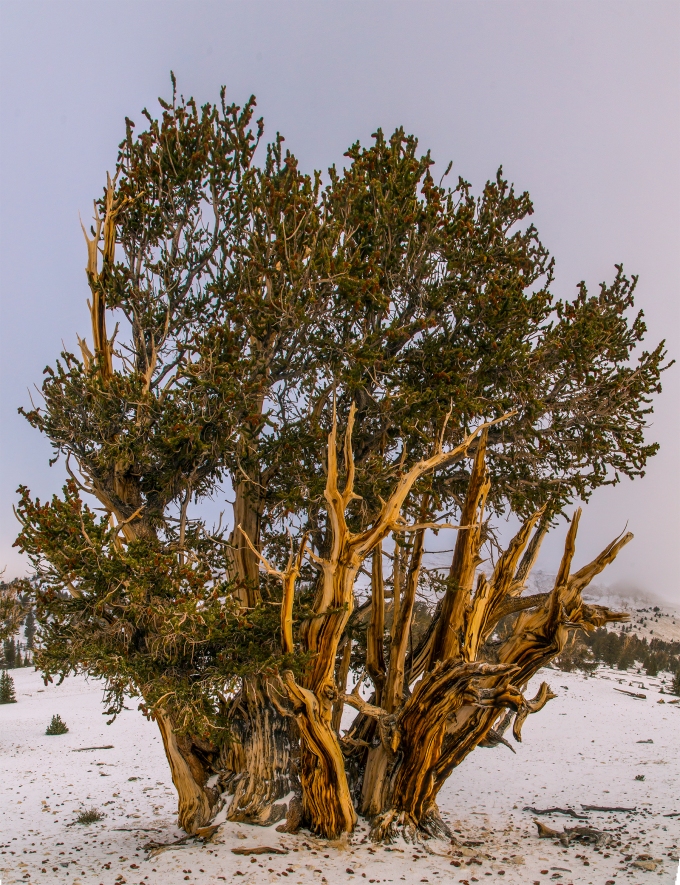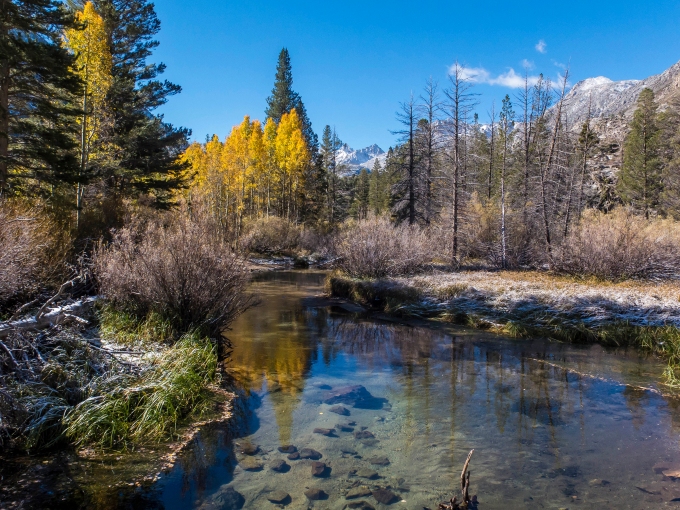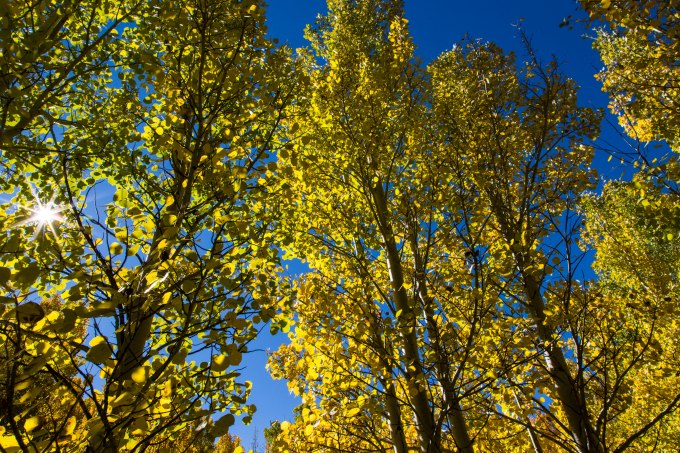th2ombre
It's ALWAYS about the light
Patriarchs and Aspens
Posted on October 17, 2018
I’m beguiled by nature, and the more colorful, the better. Southern California does have seasons, all be they more subtle than other regions of this country. Autumnal light annually speaks to Cathy and me, and again this year we acceded to it its siren call. Our plan was to drive north some 330 miles, up the Owens Valley to Big Pine, thence turn northeast and climb up into California’s White Mountains near the western boundary with Nevada to visit a strand of Bristlecone Pines in what is known as Patriarch Grove. Once finished with our homage to those ancient conifers, we set upon forays into the Sierra Madre west of Bishop for this year’s dose of raucous fall foliage.
Bristlecone Pines are the oldest living things on earth. The trees in Patriarch Grove are generally thought to be nearly 5,000 years in age. If you think in religious terms, one can’t help but be humbled. These magnificent specimens, nature’s prophets, if you will, were ancient before the time of Abraham, let alone Moses or Christ. And still they live. For me, to see them, to walk amongst them, is as if I’m in a magnificent cathedral, compelled to humble quietude, to a gulping reverence of their stately eminence gris. And in my own aging arthritic progression, they call to me as kindred spirits of our gnarled twisted corpuses. Brokenness is Beautiful?
The first part of our mission was to seek solitude with the patriarchs in the grove, a fairly challenging thing to do, given the remoteness, and the harshness of the environment. From tiny Big Pine it’s first about 23 miles climbing steeply via a paved narrow twisting single lane mountain road, and then another dozen miles by a very rough and slow-going dirt road to the scree-covered, altogether lunar site. The grove is above 11,000 feet, above what would be the tree line for many species, with these extraordinary specimens growing out of rocky alkaline soil unfit for most trees, but clearly inhabiting their own unique biological niche. As you can see, they are quite literally half dead and half alive, with the dead part giving itself that the remainder may yet live off the minuscule nutrients, the tree structure twisting in response to the harsh winds over the millennia.
Shh. Camping is not allowed at the grove, yet we were alone in that remote location, and chose to stay the night camped in the back of the van. Shh. I set out the camera atop its tripod, facing south, attached the intervalometer programmed with appropriate delays and intervals and began the capture of over 3,000 single frames to be sewn together for a “day into darkness into dawn” time-lapse, linked below. The timing was every two seconds in the light, then 25 second exposures every thirty seconds in the dark of night, with my hiking camera also pressed into service for still frames in their own right. The image above, is of the camera set up and shooting the subject bristlecone, the intervalometer hanging down next to a tripod leg. Light, camera, action!

The deep nighttime darkness of their natural habitat provides a heavenly vault upon which we twenty-first century travelers can gaze as if we were shepherds of biblical yore. Perchance to revere the ancient ones and a sky’s billions’ of years attestation to creation? To drink up the spilled celestial smear of the Milky Way closeted with those twisted souls who have watched over this for us these past five millennia? The stuff of dreams, of an unfathomable appreciation. Cosmology entwined with biology. Heady stuff.

Saturn in a star-filled sky, calmly watched by a Patriarch sentinel
Looking skyward was to figuratively stand upon a bicycle wheel hub and gaze radially upward at the “cloud” of Milky Way that arced in a continuous rim from northern to southern horizon. Lap it up.

The southern arc of the 180 degrees of north to south Milky Way
Given the elevation and the season, we knew it would be cold up there, but I’d made multiple checks on the weather forecasts which indicated clear skies to drifting high cirrus clouds without precipitation. Years ago at an FAA flight instructor meeting, where the guest speaker was a weatherman, colleague Rick Lanphier, a Navy Chief in his day job, took the “Any questions?” bait by the speaker. Slowly uncoiling to standing up all six feet five inches of his bulky frame, he boomed out “YEAH, DO YOU GUYS HAVE ANY WINDOWS WHERE YOU WORK?” Rick would be shaking his head were he with us at the Patriarch Grove, when clear skies turned into a snow storm blowing in at 02:30, lasting until after first light. I had to parka up, and trudge, slipping and sliding, the 150 yards from Odyssey van sleeping bag to find the snow-coated camera in the drifting flakes and fog, shut down the shoot and put the gadgets away with fingers dispossessed of feeling. Cold? Boy howdy. It was a sleepless night as I worried about being snowed in on those dozen miles of rough, now snow-covered dirt road. No chains, no 4WD, no cell coverage, fleeting images of the Donner party hovering in my subconscious periphery.
The early light revealed nature’s revelry, and a fantasy landscape, magical beyond anything I could have imagined or hoped to have scheduled for the shoot.



Maginot Line
Intriguingly, snow covered the landscape, but appears not to stick to the bristlecones. One of their longevity secrets?

Tolkien’s Treebeard
Before 9 we were done with the T-L and began our slow descent from the mountain. By the time we’d lost a thousand feet we were dropping below the snow. Still farther down we were treated to a nice view of the lower portion of the White Mountains, and a snippet of the Owens Valley, with the Sierras in the distance all sporting their own white ridge tops.

That Saturday was a recovery day, getting checked in at a lodging in Bishop, about 15 miles north of Big Pine via Highway 395, getting some rest after the sleepless night, and rendezvousing with middle daughter, Paisley, and her pup Lizzy, playmate to Sawyer. At the end of this day, the weather that had been predicted materialized with more snow and gusty winds.

Snow flurries, granite and Aspens
The following morning and the rest of our time there was picture postcard perfect great hiking weather. Clear skies, early morning temperatures in the upper forties, and middays in the upper sixties to low seventies. Proceeding westward up valleys into the Sierra Madre, the roads were like something out of Arizona Highways, and of course drawing out numerous leaf-peepers, although as you can see, we could find unpeopled stretches as well.



Our purpose was to put trailheads behind us, hiking into the mountains in search of exercise and agreeable vistas of golden Aspens in nearly peak color, especially after the snowfall. It was on the hiking trails where we could find solitude and more extravagant beauty.
The lower portions of the trails, if 9,000 feet can be called low, were mostly snow-free…

Antidote to rush hour traffic jambs.
…while climbing higher was on snowy, leaf-strewn trails.

The overnight snow came with wind, and a golden carpet on and beside the trail in the morning.

Sawyer gets thoroughly amped with snow, running hither and yon, chasing prey real and imagined.
This day’s hike was about a four mile roundtrip with a climb of almost exactly 1,000 feet, leading to Grass Lake.

Grass Lake at just over 10,000 feet
We came for the color, and nature did not disappoint.


Some of the Aspens were gilded, and some still green.
If you’re from my generation, you may remember the disinfectant merthiolate, now banned as it contained mercury? What I recall about it was its vibrant umber color. As you may know, while these Aspen groves are full of individually trunked trees, they are actually all part of the same plant and root structure. The groves spread underground, propagating countless individual tree trunks.


The next day’s hike was closer to five miles with a 1,700 foot climb, leading to Long Lake.

Cathy and Paisley trying to keep up with Sawyer and Lizzy

Aptly-named Long Lake
The lakes drain down valley with numerous streams.

A fallen log crossed this gurgling steam and two happy dogs fearlessly took advantage of it to explore, with Paisley in pursuit.


There are placid streams as well, bordered by dense and shaded Aspen groves. Walking in the groves is a calming experience, though the closeness of the trunks calls for care in movement and foot placement. It’s natural to look up, and be rewarded.

Aspen sunburst
The more complete name is Quaking Aspen. Each leaf is individual, at the end of a long delicate stem, attached to slender branch ends, the branches swaying, and the leaves shimmering and quaking in the breezes.


Another autumn, surprises added to the mix. Home safe and color-sated. It’s in the can. A wrap.
As ever, Tom
Category: Uncategorized Tagged:
Recent Posts
Archives
- February 2024
- June 2023
- August 2022
- August 2021
- April 2020
- December 2019
- December 2018
- October 2018
- August 2018
- July 2018
- April 2018
- December 2017
- September 2017
- August 2017
- June 2017
- May 2017
- February 2017
- October 2016
- August 2016
- December 2015
- September 2015
- July 2015
- May 2015
- March 2015
- November 2014
- August 2014
- June 2014
- May 2014
- April 2014
- March 2014
- February 2014
- January 2014
- December 2013




Recent Comments